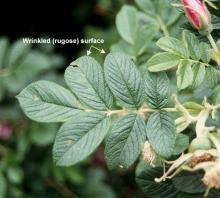Rosa rugosa
Common name:
Rugosa Rose
Beach Tomato
Sea Tomato
Pronunciation:
RO-za ru-GO-sa
Family:
Rosaceae
Genus:
Type:
Broadleaf
Native to (or naturalized in) Oregon:
No
- Deciduous shrub, 4-6 ft (1.2-1.6 m), stout upright stems, dense rounded outline. Leaves alternate, compound (odd-pinnate), 5-9 leaflets, elliptic to elliptic-obovate, 2.5-2 cm long, serrate, wrinkled surface (rugose), dark green in summer and bronze to orange-red in fall. Flowers perfect, rose-purple to white, 6-9 cm wide, short stalk, fragrant. Fruit a "hip", 2.5 cm diam., lustrous brick red.
- Sun, very pest resistant, tough and hardy, easy to grow, the most trouble free rose, used in difficult sites, e.g. banks, cuts, fills, sandy soils. Can withstand ocean salt spray.
- Hardy to USDA Zone 2 Native to northern China, Korea, Japan; naturalized in northern, western and central Europe, has been seen 100 miles from Arctic Circle in Siberia.
-
There are many selections of R. rugosa and rugosa hybrids, some of the more popular ones includes:
- ‘Alboplena’ - double white
- ‘Belle Poitevine’ - semi-double, light mauve-pink
- ‘Blanc Double de Coubert’ - semi-double to double, white
- ‘Frau Dagmar Hastrup’ - single pink
- ‘Hansa’ - double, purple-red
- ‘Will Alderman’ - double, pink
- Hips used commercially, the source of "rose hips" for tea, etc.
- rugose: wrinkled, a reference to the leaf surface, hence one of the common names, Rugosa Rose.
- Oregon State Univ. campus: south end of parking lot behind Richardson Hall.








